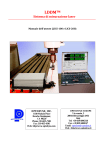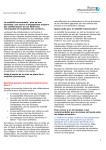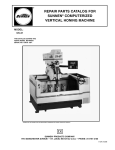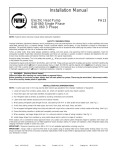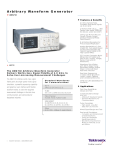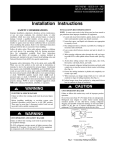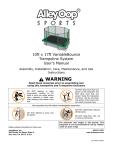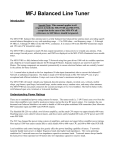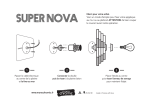Download HP Laser Interferometers
Transcript
HP Laser Interferometers P H OTO C O U RT E SY : H E W L E T T PAC K A R D , F I N L A N D . Milestones in the develoment of Displacement Interferometry: 1887 1902 1960 1964 1966 1968 1970 1972 1973 1975 A.A. Michelson’s Interferometer Pieter Zeeman, Nobel Prize for effects of magnetic fields on atomic spectra Bell Laboratories, first HeNe laser Airborne Instruments Labs, first commercial displacement interferometer HP Zeeman laser, stabilized 2 frequency output Perkin-Elmer “Lasergage”, homodyne interferometer HP 5525A Laser Interferometer, 2 frequency laser and optical heterodyning HP 10565A remote interferometer, angle/flatness measurement HP 10690A/10692B Interferometer, straightness and squareness HP 5501A Laser Transducer Rik Kneppers *) Sales Manager Europe Hewlett Packard AR Amstelveen The Netherlands 34 151/1999 Hewlett Packard has long been a pioneer of laser component technology for laser interferometry. HP’s laser technology has been applied over the years by major system integrators to build state-of-the-art systems for metrology and for an ever-increasing number of industrial applications. For example, today’s semiconductors with less than 250 nm lines and spaces would not be feasible without HP’s laser technology and the Michelson interferometer principle. Fixed mirror Figure 1. The basic Michelson interferometer. Movable mirror Monochromatic light source Beam splitter (50% reflectance) Observer HP has been a pioneer since 1966 Laser interferometer applications include some of the world’s most accurate length and distance measurement equipment. Hewlett-Packard (HP) has pioneered laser interferometry since 1966, in its use of two-frequency lasers based on the Zeeman principle, and in the mixing of light beams of two frequencies (AC or heterodyne interferometry). The HP interferometer derives its immunity to air turbulence from a new two-frequency system described in detail later in this article. Until 1966, turbulence had always been a serious problem for laser interferometers. The same heat waves that cause a distant image on the horizon to flutter, can also affect the laser beam. The effect is equivalent to intensity variation. Similar intensity variations are produced by absorption and dispersion from atmospheric contaminants. One measure of an interferometer’s ability to operate under such adverse conditions is the maximum loss of the returned beam it can tolerate. Whereas most interferometers remain comfortable with a 50 % loss of signal, the two-frequency interferometer tolerates more than 95 %. This additional margin of safety also frees the two-frequency interferometer from periodic electrical adjustments. There are no adjustments for beam intensity or trigger threshold. Furthermore, the interferometer tolerates signal variations produced when the reflector is rotated. The inventive work done by Al Bagley, Len Cutler and Joe Rando of HP led to the granting of a patent in 1970. The use of a laser transducer made it possible to perform multi-axis measurements on a moving stage in X and Y simultaneously. Despite these advantages, there were hardly any commercial applications for it when it was introduced in 1975. Later, the demands for increased accuracy for photo lithography in the semiconductor industry made the laser transducer a perfect measurement tool in wafer steppers for close loop control of the stage in X, Y and Y’. Today’s semiconductors with less than 250 nm lines would not be feasible without laser interferometry. Laser interferometry principles In the basic Michelson interferometer, monochromic light is directed at a beam splitter (a half mirror), which passes half the beam to a movable mirror (the target), while the remainder is reflected onto a fixed mirror. The reflections from the fixed and movable mirrors are recombined at the beam splitter, where their interaction is observed. Each time the movable mirror moves a distance equal to half the wavelength of the beam source, the total optical path of the reflected beams is changed by a full wavelength, and the beam reflected from the moving mirror goes through a 360° phase shift. The shifts cause alternating re-enforcement and cancellation of the two reflected beams as they rejoin, producing characteristic fringe patterns, with each cycle of intensity change representing a halfwavelength of mirror travel. Several improvements have converted the basic Michelson interferometer into a practical electronic measuring instrument. First, a laser light source permits measurement over long distances and, because of its high purity of light (single wavelength), these measurements are highly accurate. Second, the mirrors have been replaced with cube-corner retroreflectors which, unlike flat mirrors, reflect incident light parallel to the incoming direction regardless of the angle of incidence. This property reduces the need for critical alignment to generate adequate interference fringes. Finally, photocells convert fringes into voltage pulses, which are electronically processed to provide both the amount and direction of position changes. The low-power helium-neon laser in the Hewlett-Packard laser measurement system emits a coherent light beam composed of two slightly different optical frequencies, f1 and f2, of opposite circular polarization (the Zeeman split). After conversion to orthogonal linear polarization, the beam is expanded and collimated, then directed to the reference beam splitter, where a small fraction of both frequencies is split off. This portion of the beam is used both to generate a reference frequency and to provide an error signal to the laser-cavity tuning servo. The difference in the dc levels of f1 and f2 is used for reference and goes to a counter in the laser display unit. The major portion of the beam passes out of the laser head to an interferometer. All Hewlett-Packard interferometers measure the relative displacement of the two reflectors by splitting the beam into f1 and f2, directing them to two retroflectors, and returning the resultant signals to a photodetector. Laser Interferometer System error components There are many Laser Interferometer System error components, and these can be divided into three categories: 1. Intrinsic (laser wavelength accuracy, measurement resolution, optics non-linearity) 2. Environmental (atmospheric compensation, material expansion, optical thermal drift) 3. Installation (deadpath error, cosine error, abbé error) In this article, only the atmospheric compensation will be explained in detail. 151/1999 35 Atmospheric Compensation It is common practice to specify the wavelength of the laser source as the vacuum wavelength ln. In a vacuum this wavelength is constant, but in any non-vacuum environment it is dependent on the index-of-refraction of the environment. Since most laser interferometer systems operate in air, it is necessary to correct for the difference between ln and the wavelength in air la. The index-ofrefraction n of the air is related to ln and la by: n = ln / la [1] Changes in air temperature, pressure, composition and humidity cause changes in the index-of-refraction, thereby changing the needed correction to the interferometer measurement. Without proper correction or compensation, there will be degradation in system accuracy. For example, assuming standard and homogenous air composition, a one part-per-million error will result from any one of the following conditions: – 1 °C (2 °F) change in air temperature – 2.5 mm (0.1 inch) of mercury change in air pressure – 80 % change in relative humidity The wavelength correction or compensation number (WCN) is the inverse of the index-of-refraction number: WCN = la / ln [2] Since the laser interferometer system counts the number of wavelengths of motion traveled (fringes of light), the actual displacement can be determined as follows: Actual displacement = (wavelength counts) * WCN * ln [3] This wavelength compensation number can be derived by direct measurement of the index-of-refraction with a refractometer or by using empirical data. In the absence of a refractometer, it is best to measure the air pressure, temperature and relative humidity, and then to relate this data to the refractive index using the formulas of Barrel & Sears [2] and Edlen [3]. This method gives only an approximation of the index-of-refraction, and thus has some limitations. The accuracy of measuring the atmospheric conditions and the formula will determine the magnitude of this error component. HP calculates the compensation factor to an accuracy of 0.1 ppm by using the following formulas: T = Air Temperature P = Air Pressure H = Relative Humidity Metric English °C mm Hg % °F inch Hg % The use of these formulas suffers from the following disadvantages: This error term is typically specified in parts-per-million (ppm) and is a proportional term. • indirect measurement • slow response, due to sensor time constants • sensors are subject to errors • sensors require periodic calibration • ignores air composition changes in, e.g. - carbon dioxide - nitrogen - chemical vapors Wide range of applications The assumption that the environment measured by the sensors will be the same as in the interferometer measurement path, is often not true. Especially in the nanometer arena the air composition might not be homogenous (e.g. air pressure variations, air turbulence). The magnitude of the Atmospheric Compensation error term is dependent on the type of environment, how much the environment changes during an interferometer measurement and the accuracy of the method of compensation used. Figure 3. The X-Y stage layout picture. 6 Compensation Factor C= 10 6 N + 10 Metric: é1 + 10 6 * P * (0 .817 - 0.0133 * T )ù -3 0.057627*T ú - 3.033 *10 * H * e N = 0. 3836391 * P * ê 1 + 0. 0036610 *T ë û English: é 1 + 10 6 * P * (26 . 7 - 0 . 187 * T ) ù 0.032015*T -3 N = 9 . 74443 * P * ê ú - 1 . 0899 * 10 * H * e ë 0 .934915 + 0. 0020388 * T û 36 151/1999 Laser interferometers are used for high precision measurements of distances from nanometers till 80 m, but also for measuring angles, flatness, straightness, squareness, velocity and acceleration (vibrations). They are mainly used in one of the following areas: • Standard laboratories For measuring the length standard and calibrating laser interferometers and measurement tools. • Machine Tool calibrations Calibration of Machine Tools to check if they can produce parts within the required specifications (microns). Measurements are performed according to standards like ISO, VDI, BSI, JIS, ANSI, and NMTBA. Also needed for ISO9000 machine certification. quarter wave plate causes the polarization of the return frequency to be rotated through 90 degrees, so that it will be reflected out a second time), one can measure the position in X and Y, while the stage can be moved in two dimensions. The positioning measurement and movement of the stage can be performed in open or closed loop control. Positioning data needs to be corrected for the atmosphere (air sensor/wavelength tracker), mirror flatness, abbé error, data aging etc. Adding extra interferometers can solve the abbé errors. For instance, two interferometers on the Y axis (Y and Y’), separated by a distance D, will measure the yaw in Y = arctan ((Y-Y’)/D). Stages are traveling faster and faster and data aging is becoming a problem. Data aging is the delay between the time you take a position on the fly and the time this data becomes available. The moment the data becomes available, it does not represent the actual positioning of the stage anymore. For example, at a velocity of 500 • Measuring machines For increased (submicron) accuracy of high precision machines. • Servo track writing Used in the data storage industry for writing tracks on each hard disk manufactured, before it can be used in a PC or workstation, for example. 10,000 tracks per inch or higher can be used today in high capacity hard disks. –X-Y stage positioning and control for the semiconductor industry X-Y stage positioning X-Y positioning is used in wafer steppers, probing, inspection stations and electron beams to provide relative accuracy and repeatability in the nanometer area. Figure 3 shows an example of a typical X-Y stage layout. The ‘Object Under Control’ is a stage with long plane mirrors on the X and Y sides. By using plane mirror interferometers (an interferometer with a mm/s and at 1 micro second of data aging (caused by the receivers, cables and electronics), the stage is always off by 500 nm. With constant velocity this is easy to compensate for, but gets more complex with accelerations. In practice, however, data aging is never constant, but will slightly change due to changes in signal amplitudes (alignment), frequency (doppler shifts), temperature variations, propagation delays etc. This change is called variable data aging and cannot be easily compensated for. When entering the submicron arena, extreme precaution should be taken with the environment. The stage and interferometers should be inside a conditioned chamber in which the air temperature and pressure (or turbulence) are tightly controlled (or ■ even in vacuum). Figure 2. A block diagram of the HP laser measurement system. HP Laser Measurement System Second channel Reference beam splitter Measurement photodetectors To interferometer Telescope 2-frequency HeNe Laser l/4 and l/2 plates f1 and f2 Reflected Beam Demodulating polarizer Doppler preamplifier Mirror Laser head Polarizing beam splitter Doubler f1-f2±Df Forward counter SDf Calculator Photodetectors Subtractor Reference preamplifier Laser tuning regulator f1-f2 Doubler Forward counter and Dispaly Display Unit Vaisala’s instruments in laser interferometry applications Vaisala’s barometers, and relative humidity and temperature transmitters, have been used for the active wave-length-of-light compensation of laser interferometer systems with good results. Laser interferometer technology is based on the Michelson principle, invented over a hundred years ago. The interferometer principle enables distance measurements to be made at very high resolution, and accordingly the most accurate length and distance measurement equipment in the world relies on laser interferometer technology. Applications range from calibration standards for gauge blocks to semiconductor wafer exposure systems, to vibration and surface contour analysis systems. Vaisala’s barometers and relative humidity and temperature transmitters are used for the active wave-length-of-light compensation of laser interferometer systems. In air, the wavelength of light changes with the refractive index of air which, as such, is affected by the temperature, absolute pressure and relative humidity of air. Vaisala offers various measurement solutions for the environmental control of laser interferometer systems, using measurement technology that was originally developed for the most demanding meteorological applications. The built-in accuracy, stability and reliability of Vaisala’s instruments can nowadays be applied to the most demanding industrial systems, too. Second channel References *) The author, Rik Kneppers joined Hewlett Packard (HP) in 1979 and has dedicated the last 12 years to working in the area of laser interferometry technology. As a representative of HP Santa Clara Division (interferometry R&D and manufacturing), he provided submicron application and design support to the precision mechanical industry and research institutes. Over the years, he has been actively involved with new interferometer developments to address the increased accuracy and throughput demands of the semiconductor industry. He is currently working as sales and marketing manager, heading the HP Precision Motion Control Group in Europe, of which laser interferometry is a part. [1] Quenelle, R.C. Nonlinearity in Interferometer Measurements, HP Journal April 1983. [2] Barrell, H. & Sears, J.E., (1939) Phil Trans. Roy. Society, A258, 1-64 [3] Edlin, B., The Refractive Index of Air, Metroligia, Vol.2, No.2, 71, 1966 151/1999 37




